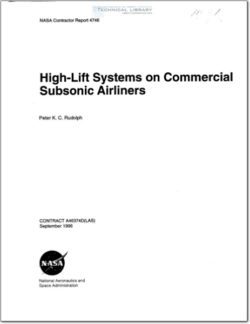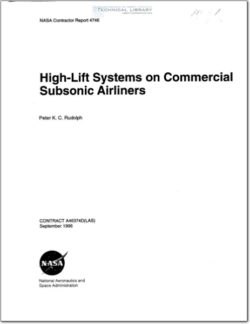NASA-CR-4746

- Version
- 2778 Downloads
- 7.26 MB File Size
- 1 File Count
- April 6, 2016 Create Date
- April 6, 2016 Last Updated
High lift Systems on Commercial Subsonic Airliners

Ames Research Center
Introduction
The early breed of slow commercial airliners did not require high-lift systems because their wing
loadings were low and their speed ratios between cruise and low speed (takeoff and landing) were
about 2:1. However, even in those days the benefit of high-lift devices was recognized. Simple
trailing—edge flaps were in use, not so much to reduce landing speeds, but to provide better glide-
slope control without sideslipping the airplane and to improve pilot vision over the nose by reducing
attitude during low-speed flight.
As commercial—airplane cruise speeds increased with the development of more powerful engines,
wing loadings increased and a real need for high-lift devices emerged to keep takeoff and landing
speeds within reasonable limits. The high—lift devices of that era were generally trailing-edge flaps.
When jet engines matured sufficiently in military service and were introduced commercially,
airplane speed capability had to be increased to best take advantage of jet engine characteristics.
This speed increase was accomplished by introducing the wing sweep and by further increasing
wing loading. Whereas increased wing loading called for higher lift coefficients at low speeds,
wing sweep actually decreased wing lift at low speeds.
Takeoff and landing speeds increased on early jet airplanes, and, as a consequence, runways
worldwide had to be lengthened. There are economical limits to the length of runways; there are
safety limits to takeoff and landing speeds; and there are speed limits for tires. So, in order to hold
takeoff and landing speeds within reasonable limits, more powerful high-lift devices were required.
Wing trailing-edge devices evolved from plain flaps to Fowler flaps with single, double, and even
triple slots. Wing leading edges evolved from fixed leading edges to a simple Krueger flap, and from
fixed, slotted leading edges to two— and three-position slats and variable-camber (VC) Krueger flaps.
The complexity of high—lift systems probably peaked on the Boeing 747, which has a VC Krueger
flap and triple—slotted, inboard and outboard trailing—edge flaps. Since then, the tendency in high—lift
system development has been to achieve high levels of lift with simpler devices in order to reduce
fleet acquisition and maintenance costs.
| File | Action |
|---|---|
| NASA-CR-4746 High lift Systems on Commercial Subsonic Airliners.pdf | Download |

Comment On This Post